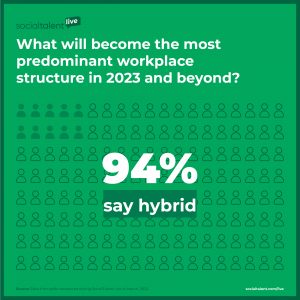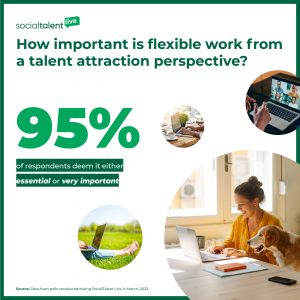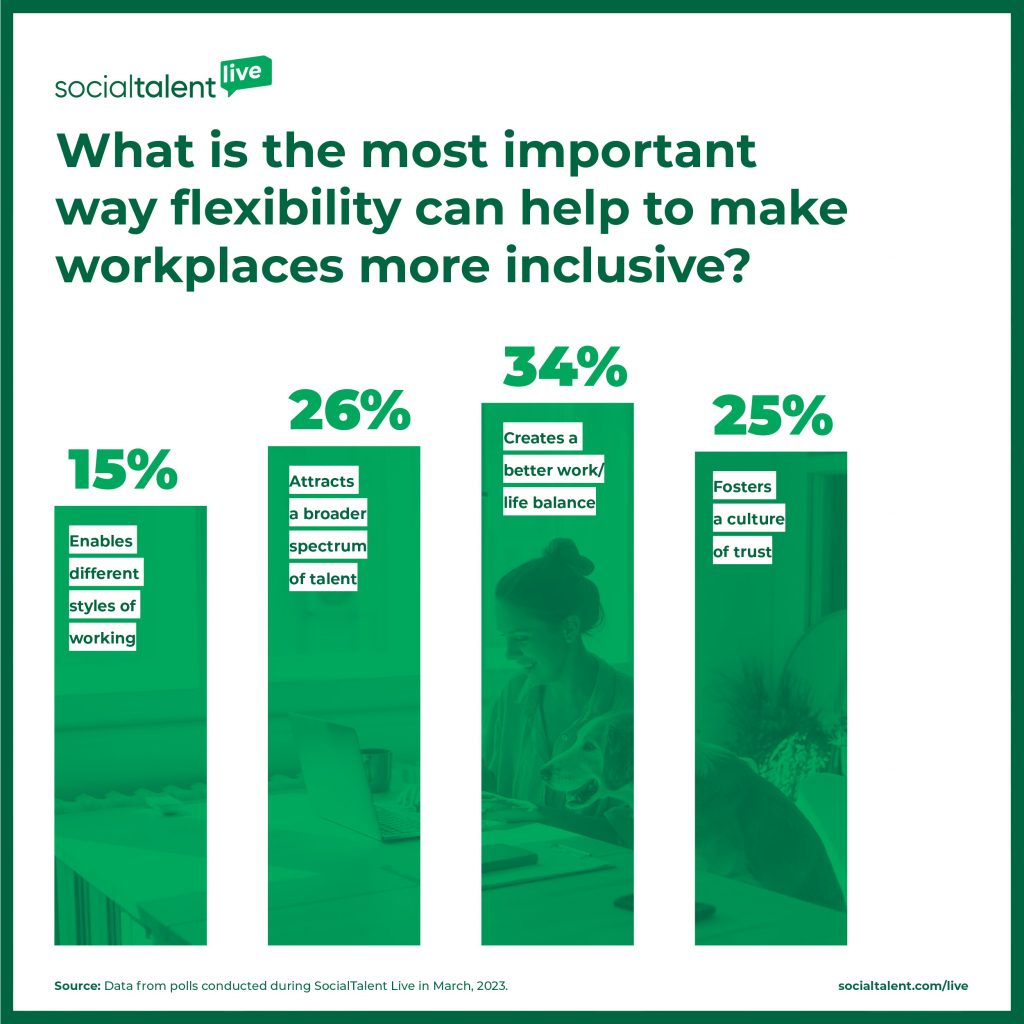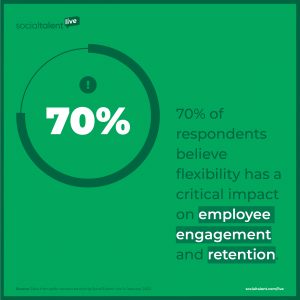Flexing for Success: The non-negotiable reality of flexible work
There’s no use trying to deny it – flexible work is the future. Life is far too complex to create impermeable rules about how and where people work. It’s limiting and short-sighted. By embracing a flexible mindset, one which encourages organizations and leaders to move beyond stalwart tradition, you start yourself on a journey to build a workplace that is agile and innovative. One that champions a company’s greatest resource – its talent.
Things can’t change overnight, however. But the appetite is there. SocialTalent recently hosted a webinar that brought hundreds of Talent, HR, and People leaders together to dig into this topic of flexibility. We polled our audience about the future of the model, its impact on engagement and retention, how it interacts with DEI, and so much more. In this article, we’re going to dive into the results.
1. Hybrid work will become the predominant workplace structure
 94% of our audience believe that hybrid work will become the most popular structure. It wasn’t a huge surprise to hear this either – in the immediate aftermath of COVID, people became evangelical about full remote options. But as with most things, the middle-ground is usually the best option. Hybrid work empowers teams and individuals to operate in the way that best suits them. Because we all know that there are times when in-person is preferable and there are times when having the option to work from home is the way to go – and it’s a different spectrum for everyone. During his SocialTalent Live fireside chat, Intercom CPO L. David Kingsley referred to hybrid work and the policies surrounding it as a “dimmer switch” and not something that just flips on or off. “It’s not fully art nor fully science – it’s a little bit of both, and it takes that human touch.” So if operating in a hybrid capacity is to become the most ubiquitous model, it will require organizations and leaders to be mindful and open to evaluation when it comes to how their teams work.
94% of our audience believe that hybrid work will become the most popular structure. It wasn’t a huge surprise to hear this either – in the immediate aftermath of COVID, people became evangelical about full remote options. But as with most things, the middle-ground is usually the best option. Hybrid work empowers teams and individuals to operate in the way that best suits them. Because we all know that there are times when in-person is preferable and there are times when having the option to work from home is the way to go – and it’s a different spectrum for everyone. During his SocialTalent Live fireside chat, Intercom CPO L. David Kingsley referred to hybrid work and the policies surrounding it as a “dimmer switch” and not something that just flips on or off. “It’s not fully art nor fully science – it’s a little bit of both, and it takes that human touch.” So if operating in a hybrid capacity is to become the most ubiquitous model, it will require organizations and leaders to be mindful and open to evaluation when it comes to how their teams work.
2. Looking to land talent? Lean in to flexibility
 The talent shortage isn’t going to end any time soon. According to ManPower, 77% of organizations are reporting difficulties in finding talent, while Korn Ferry believe the talent shortage could result in $8.5 trillion in unrealized annual revenues. It’s time to start taking this threat seriously. And one of the first things companies need to do is understand exactly what candidates are looking for right now. Outside of salary, one of the biggest non-negotiables is in relation to flexible work. Our research has found that 95% of TA and HR leaders deem flexibility as either essential or very important from a talent attraction perspective. The proof is in the pudding – LinkedIn job posts that mention remote work get as many as 50% more applications. But remember: it’s not enough just to promise flexible work, your organization must follow-through and ensure this is embedded in the culture.
The talent shortage isn’t going to end any time soon. According to ManPower, 77% of organizations are reporting difficulties in finding talent, while Korn Ferry believe the talent shortage could result in $8.5 trillion in unrealized annual revenues. It’s time to start taking this threat seriously. And one of the first things companies need to do is understand exactly what candidates are looking for right now. Outside of salary, one of the biggest non-negotiables is in relation to flexible work. Our research has found that 95% of TA and HR leaders deem flexibility as either essential or very important from a talent attraction perspective. The proof is in the pudding – LinkedIn job posts that mention remote work get as many as 50% more applications. But remember: it’s not enough just to promise flexible work, your organization must follow-through and ensure this is embedded in the culture.
Don’t become a victim of flex-washing in your job posts! Read Johnny Campbell’s newsletter on the topic to learn more.
3. Flexible work improves DEI
According to Forbes, in order to build a fairer future of work, “accessibility and flexibility must remain at the heart of hiring and employee experience.” And it’s no mystery why. Offering employees choice in how and where they work instantly broadens the scope of inclusion and equity. You are giving people agency and opening the floodgates to talent that would otherwise have been blocked from entry. Our panel discussion on this topic shed further light on this, demonstrating how embracing flexibility increased the number of women entering the workplace and enabled even playing fields for international meetings. And when we polled our audience about what they saw as the most important benefit for diversity, equity and inclusion, the results were fairly split. Flexible work gives us an incredible opportunity to build an environment of balance and trust. It allows people to operate in ways that play to their strengths and makes organizations even more attractive from a talent perspective.

4. The secret ingredient to employee engagement
 Engagement is an ongoing war for employers. Constantly looking for ways to buoy their employees, it can be a difficult metric to contend with. Especially when we know from Gallup that only 32% of US employees feel actively engaged in their work. And with the impacts of disengagement being so severe (attrition, performance, culture, etc.), it’s never been so important to improve this narrative. So what can organizations do? Just like with talent attraction, it comes down to understanding what employees want. And our survey found that 70% of respondents believe flexibility is of critical importance to both employee engagement and retention. The tides have changed since the pandemic. The taste of work/life balance, autonomy, and trust has sparked a non-negotiable need for workers. To the point that they’re even sacrificing salary to ensure their chosen organization values and promotes genuine flexibility. A 9-5, location tethered, dictatorial position simply can’t cultivate an engaged workforce.
Engagement is an ongoing war for employers. Constantly looking for ways to buoy their employees, it can be a difficult metric to contend with. Especially when we know from Gallup that only 32% of US employees feel actively engaged in their work. And with the impacts of disengagement being so severe (attrition, performance, culture, etc.), it’s never been so important to improve this narrative. So what can organizations do? Just like with talent attraction, it comes down to understanding what employees want. And our survey found that 70% of respondents believe flexibility is of critical importance to both employee engagement and retention. The tides have changed since the pandemic. The taste of work/life balance, autonomy, and trust has sparked a non-negotiable need for workers. To the point that they’re even sacrificing salary to ensure their chosen organization values and promotes genuine flexibility. A 9-5, location tethered, dictatorial position simply can’t cultivate an engaged workforce.
The positive implications for embracing this flexible work movement are far-reaching. And while it feels like the wheels are turning in the right direction, there is still so much to do. The traditional workplace scaffolding cannot be removed overnight, but it’s clear that employees aren’t shying away from their demands. Hybrid environments that lean into flexibility, rather than fight against it, are the future. There’s no going back!
